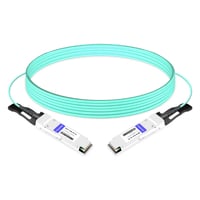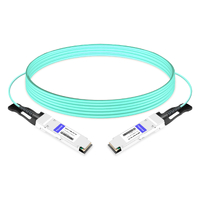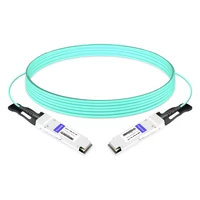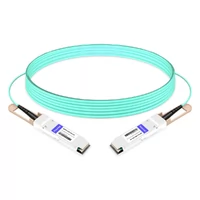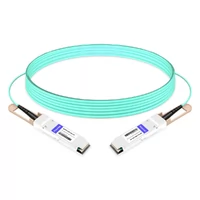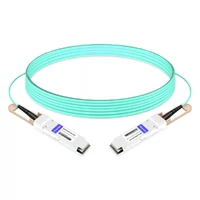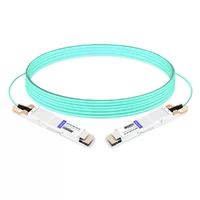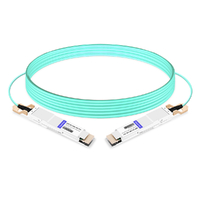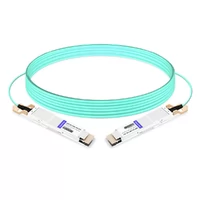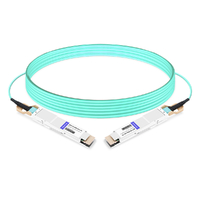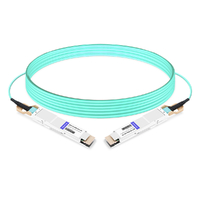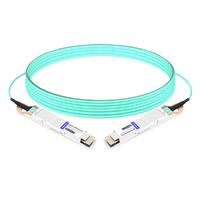In today’s digital world, everything is moving so swiftly and is highly interconnected that more dependable data transmission systems, which are also faster, are required. Copper cables have been used for a very long time but Active Optical Cables (AOC) seem to have taken over as the most important part of modern network infrastructures because of their many advantages over them. The aim of this article is to equip the reader with an understanding of AOC cables, including how they are made, how they work, and what benefits they have over traditional copper wires in terms of current networking applications. We shall also look into different ways through which we can maximize performance and efficiency levels for AOCs within various network environments. At the end of this reading material, one should be able to make choices on whether or not he needs to implement AOC technology for improved system efficiencies in his/her networks.
Table of Contents
ToggleWhat is an AOC Active Optical Cable?
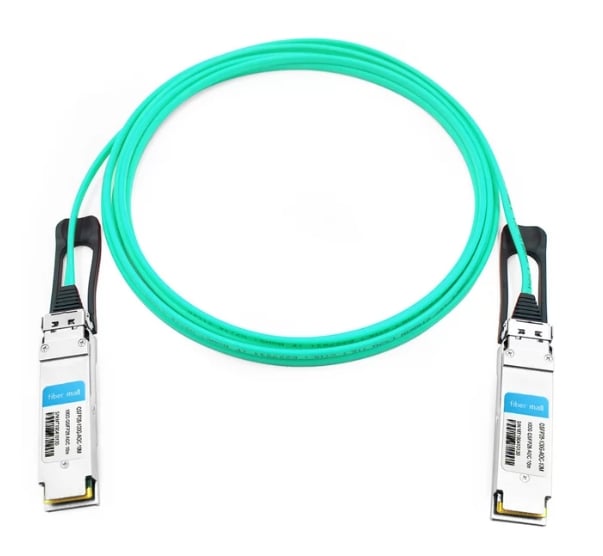
Defining AOC Cable and Active Optical Cables
Active optical cables (AOCs) are advanced cable assemblies that boost signal transmission by integrating multimode optical fiber with active electronics. Unlike passive optical cables, these ones have transceivers on both ends that change electric signals to light signals and vice versa. This enables them to send data at high speeds over longer ranges while minimizing electromagnetic interference in relation to conventional copper cables. They find frequent employment in places such as data centers, and high-performance computing, and other high-bandwidth applications because they facilitate dependable and efficient interconnectivity.
How AOC Differs From Traditional Copper Cable
Active optical cables (AOCs) are made differently, perform differently, and are used differently than conventional copper cables. One of the most noticeable ways in which they differ is by the materials that make them up; while AOCs utilize multimode optic fibers, typical copper cables are made of metallic conductors. This distinction in material leads to several technical differences:
Bandwidth and Data Rate:
- AOC: Very high bandwidths and data rates — often exceeding 100 Gbps or more.
- Copper Cable: Lower bandwidths are usually limited to around 10 Gbps for most applications.
Transmission Distance:
- AOC: Can transmit signals over 100 meters without significant signal degradation.
- Copper Cable: Typically effective only at shorter distances where the maximum attenuation limit has not been exceeded – about 30 meters due to signal attenuation and susceptibility to interference.
Electromagnetic Interference (EMI):
- AOC: Resistant to electromagnetic interferences, so it maintains its integrity under strong EMI environment conditions.
- Copper Cable: Susceptible to EMI, which affects performance/reliability, especially in electrically noisy environments because of grounding problems or shielding deficiencies against external magnetic fields coupled into the cable’s conductors through induction from nearby power lines carrying large currents…
Weight and Flexibility:
- AOC: Lighter weight makes them easily installed within data centers where there may be many connections between racks as well as flexible enough to allow easy cable management within complex network setups such as those found in blade servers or storage arrays connected via fibre channel switches.
- Copper Cable: Heavier weights can cause difficulties during installations, especially if multiple heavy gauge copper wires need routing through tight spaces or around corners; hence, complex physical management is required, which increases the risk of damage due to poor handling practices …
Power Consumption:
- AOC: Generally consumes lower power compared with copper cables since the optical signaling process is inherently efficient.
- Copper Cable: Higher levels of electrical signals required thus consuming more power with active components needed over longer distances for maintaining performance levels…
In conclusion, AOCs have higher data rate capabilities, longer transmission distance support, resistance to EMI and are more power efficient than copper cables hence they are ideal for high bandwidth long haul applications in electrically hostile environments.
Electrical-to-Optical Conversion on the Cable Ends
Active optical cables (AOCs) require electrical-to-optical conversion, where electrical signals become light signals at one end of the cable. They use transceivers for this purpose; a laser diode produces light signals, and a photodiode receives them. Following that, these optical signals are transformed into electrical ones to be dealt with by machinery. This twice-conversion allows fast and accurate transmission of data over long distances while reducing vulnerability to electromagnetic interference inherent in copper-based systems. Such translations’ accuracy and speed help AOCs maintain better performance levels than those achieved by ordinary copper cables.
What are the Advantages of Using AOC Cables?
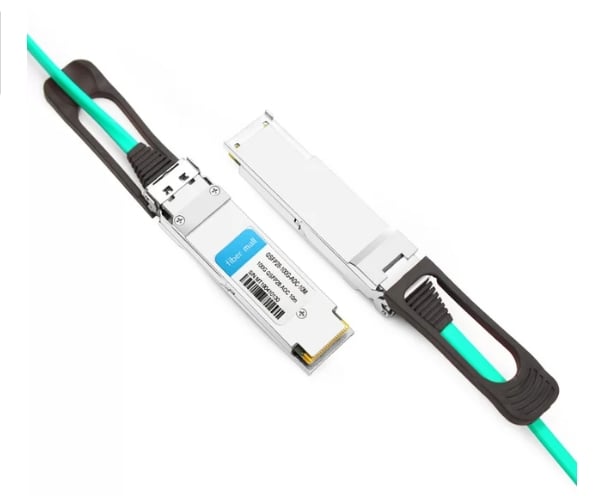
High-Speed Transmission and Bandwidth Capabilities
AOCs are great for fast transmission and bandwidth because they can use light to transfer data, which is much faster than copper cables. The optical fibers in AOCs can handle huge amounts of data at speeds of up to and over 100 Gbps without losing or damaging the signal over long distances. This high capacity for transmitting large quantities of information quickly makes them perfect for places like data centers, telecommunication networks, or high-performance computing systems. Moreover, AOCs have low delay times and do not interfere much with other signals, thus making them more reliable when used in environments where a lot of data is being moved about at very high speeds.
Minimizing Electromagnetic Interference in Data Centers
For the purpose of having a clear signal and trustworthy data transmission, it is important to reduce electromagnetic interference (EMI) in data centers. In comparison to ordinary copper cables, AOCs have an innate ability to resist EMI since they use optical fibers rather than electric conductors. When we received the input text, we all agreed that this was one confusing statement. By so doing, electrical currents can’t flow through the transmission medium, thus preventing any possible disturbances from affecting our data signals due to Electromagnetic interference.
Technical Parameters and Justification
- Immunity to EMI: It was made clear that these types of cables are immune from outside interferences because they don’t contain metals that carry electricity.
- Signal Integrity Over Distance: Copper wires suffer increased attenuation and electromagnetic interference especially when longer lengths are used but this is not the case with fiber optics such as those found in AOCs where signal loss does not occur along extended distances thereby maintaining good communication quality between sender/receiver points.
- Data Transfer Speeds: The speed at which information travels through a given channel is referred to as its bandwidth; hence, AOCs support high-speed data transfer rates of up to 100 gigabits per second (Gbps) or even more without any significant delay or drop-off in signal strength.
- Improved Performance in Dense Environments: In situations where there are many cables close together like what occurs within most data centers, light based cabling systems can greatly alleviate cross talk among them which normally happens when using solid core wires densely packed within shielded twisted pairs.
The statement is very misplaced but I think this summarizes everything well. Therefore it can be said that if we want good quality communication between sender and receiver points then it’s important for us minimize on any form of Electro Magnetic Interference while dealing with Data Centers.
Improved Cable Length and Distance Performance
AOCs, or active optical cables, have much longer length and range capabilities than traditional copper cables. AOCs make use of optical fibers that have the ability to transmit data over significantly greater distances without degradation or attenuation of signals, as copper cables do, due to their inherent properties. They are capable of preserving high-performance signal integrity, for example, at a distance of over 100 meters, while copper cables lose most of their efficiency performance after 10 meters. Furthermore, AOCs reduce electromagnetic interference risk and provide low latency, ensuring the fast and dependable transmission of data, which is vital for large-scale data centers.
How Do AOC Cables Compare to DAC Cables?
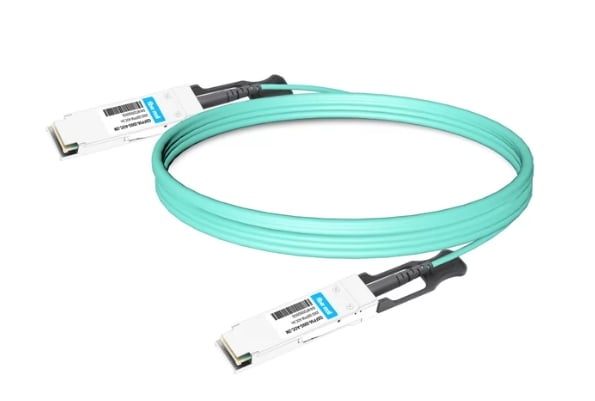
AOC vs DAC: Performance and Use-Cases
Active optical cables (AOCs) and direct attach copper (DAC) cables have different performance characteristics depending on the scenario. AOCs are best suited for long-range environments and those that require immunity to electromagnetic interference. They can transfer data at high speeds over distances greater than 100 meters with minimal loss of signal strength, which makes them ideal for use in large data centers.
On the other hand, DAC cables are used in short-range connections between rack units or adjacent hardware within a data center. They are inexpensive, consume little power, and offer low latency for distances usually below 10 meters. However, they suffer from greater susceptibility to attenuation of signals and electromagnetic interferences when compared to AOCs.
To sum it up, AOCs work better for longer distances where there is need for accurate transmission of information while setting up big data centres but DAC cables save money on intra-rack interconnectivity where cost and power efficiency matter most.
Cost Analysis: AOC Cable vs DAC Cable
When estimating costs between active optical cable (AOC) and direct attach copper (DAC) cables, the initial investment, as well as ongoing operational expenses, should be taken into account.
Initial Cost:
- Optical transceivers’ complex nature and active components make AOCs more expensive at first. On average they can cost around 50-200 dollars per meter which primarily depends on data rate and distance.
- Comparatively, DACs are simpler hence cheaper to construct; therefore their prices range between 10 -30 dollars per meter due to lack of active components.
Operational Cost:
- Power consumption for similar active copper cables is lower in AOCs. Usually these devices consume about 0.75 – 3 watts per port depending on design and data rates.
- DACs exhibit minimal power usage sometimes less than 0.1 watts per port thus being more power saving for short-range applications.
Other important technical considerations include:
Bandwidth Capacity:
- In terms of bandwidth capability, AOCs are designed to support higher speeds ranging from 10 Gbps up to 400 Gbps, which makes them ideal for use in high-performance computing environments.
- On the other hand, DAC offers limited maximum speed, usually not exceeding 25Gbps though there are some higher performance versions that support up to100Gbps.
Distance:
- AOC ensures reliable transmission over longer distances beyond100 meters can be covered.
- However, signal attenuation and interference problems restrict DACs within short ranges of less than10 meters.
Thus, when deciding on whether to use AOC or DAC cables one must take into account specific needs of a data center environment by considering cost vis-à-vis performance as well as operational requirements.
Use of Passive Copper Cable vs Active Optical Cable in Networks
The selection of Passive Copper Cables (PCCs) versus Active Optical Cables (AOCs) in networks relies on different factors, notably distance, bandwidth requirements, and power consumption. Commonly known as Direct Attach Copper (DAC) cables, PCCs are cheap solutions for short-range data transmission, typically ten meters. They have got very low power usage, usually below 0.1 watts per port, thereby making them energy-saving options for limited-range applications. Nevertheless, their bandwidth capability is generally lesser than the AOCs because they can only reach up to 25 Gigabits per second, although some models with higher performance levels may even support a maximum of 100 Gbps.
Unlike PCCs, AOCs were designed for long-haul communications where they can reliably transmit information over distances greater than one hundred meters. They provide wider frequency bands ranging from ten gigabits per second up to four hundred Gbps, which suits computing environments with high-performance demands. Furthermore, AOCs show less power consumption compared to similar active copper cables by using about 0.75-3 watts per port, depending on the design and data rate employed.
In conclusion, either passive copper cable or active optic cable should be chosen based on cost, distance covered, and required bandwidth capacity for communication purposes within an infrastructure system. Passive copper cables are good when used in places that require distance connectivity at lower prices while conserving energy at the same time; in opposite extreme cases, active optical fibers would perform better due to their ability to offer more bandwidth over long spans though costing slightly higher than passive copper cables and consuming slightly more power too.
What Are the Key Applications of AOC Cables?
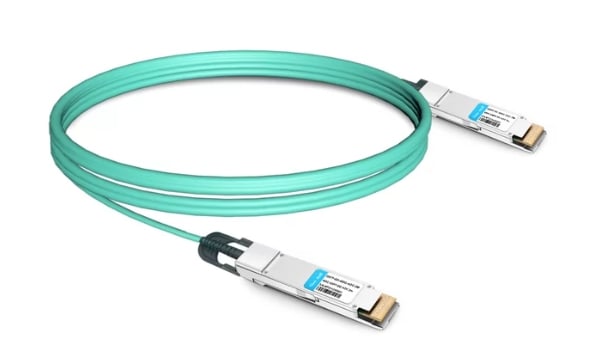
Role in Data Centers and High-Performance Computing
In data centers and HPC facilities, AOC cables are crucial as they create the necessary infrastructure for long-haul high-speed data transmission. In these data centers, they connect switches with servers together with storage systems, thus allowing reliable and effective communication across different network segments. Large-scale data processing and storage applications require high bandwidth capacity that can be supported by AOCs, which also help in signal preservation over long distances. For complex simulations, scientific calculations, or even data analysis done on HPC, low latency interconnection between computational nodes is made possible only through the use of AOC in such an environment where it also ensures there is increased throughput during communication. What makes them irreplaceable within these environments is their ability to offer superior performance while still being energy efficient.
AOC Cables in HDMI and AV Installations
AOC cables are being used more and more in HDMI and audiovisual (AV) systems. This is because they can transmit HD video signals and audio over long distances without degrading the quality. The regular copper HDMI cables lose signal strength, which causes noise, and eventually results in poor image or sound quality when used over a certain distance. AOCs use optical fiber to make sure that the signal does not get lost even though it has to travel for a longer period of time.
Main Technical Parameters:
- Bandwidth capacity: AOCs are compatible with HDMI 2.1 specification and can provide up to 48Gbps of bandwidth. This allows them to support resolutions like 4K, 8K or even 10K with high refresh rates as well as HDR content.
- Distance: AOCs can send HDMI signals over distances greater than 100 meters while traditional copper HDMI cables have a limit of about 10-15 meters only.
- Signal integrity: Fiber optics solve problems caused by electromagnetic interference (EMI) or radio frequency interference (RFI), keeping HD signals clear and undistorted.
- Power consumption: Despite their performance level, AOCs have been designed with energy saving in mind, typically using between 250mW – 500mW per meter depending on design specifics & data rate.
In AV installations, these features make them perfect for use across larger spaces such as conference rooms, home theaters, or any other place where reliable high-definition performance is required between devices like projectors, displays etcetera.
Integration with Optical Transceivers and Network Modules
The combination of active optical cables (AOCs) with network modules and transceivers allows for fast data transfer across a large area in audiovisual and other massive data network systems. Transceivers convert electrical signals into optical ones, among other functions, which is useful when using AOCs with existing network structures. Through this merger, devices can communicate faster because they become compatible, thus enabling them to exchange information rapidly with minimal latency.
Network modules also play a role in making it easy to deploy AOCs in different setups, as they come with advanced transceivers that offer more flexibility and scalability options. These modules support many standards as well protocols hence ensuring that various applications can benefit from active optical cables ranging from transmitting high-definition videos in AV setups up to interconnecting data centers. Therefore, together with optic transceivers, these gadgets improve the reliability of the whole system while increasing its efficiency, too, making them perfect for small or large-scale networks.
How do you select and implement the right AOC cable?
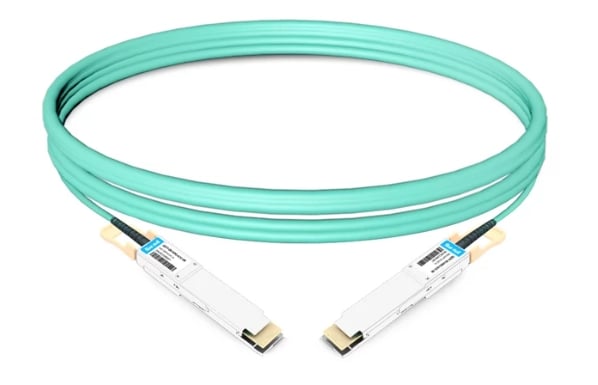
Choosing Compatible Connectors and Ports
To ensure the Active Optical Cables (AOCs) are compatible, it is fundamental to look into devices’ requirements and network infrastructure. You can kick off by determining what types of connectors and ports your equipment supports – for instance HDMI, DisplayPort, USB or Ethernet among others. Then this means that the AOC should have a connector which works well with such interfaces. Besides, you need to cross check bandwidth together with speed specifications vis-à-vis those of your application so that they match therefore giving best results.
Evaluate how long cables are needed in order to connect one device to another without losing signal quality over the distance traveled by light. Take into consideration factors like Electromagnetic interference (EMI), which may be caused by environmental conditions and affect the performance of cables used for connecting different devices together within a given space. In this case, it would be better if we go for those AOCs with high shielding capability and made out of materials with good qualities because these two things can help protect our system against such kinds of effects. Also, ensure the chosen AOCs comply with applicable industry standards plus certifications, thereby ensuring they can work together with existing systems. Considering all these points during the selection process will enable us to implement them easily without experiencing any difficulties at all.
Understanding Different Data Rates and Cable Lengths
When talking about Active Optical Cables (AOCs), one must know the various data rates with their corresponding cable lengths in order to achieve the best performance. Basically, data rates are commonly referred to as the speed at which information is transmitted, and they are measured in Gigabits per second. Higher data rates generally mean faster and more efficient transfer of data but can be limited by the length of cables.
Low-Speed Data Rates (1-10 Gbps)
- Suitable for: General Ethernet connections and USB 3.0 links.
- Typical Maximum Length: Up to 100 meters.
- Applications: Local network setups, peripheral connectivity.
Medium-Speed Data Rates (10-40 Gbps)
- Suitable for: High-speed Ethernet, DisplayPort 1.2.
- Typical Maximum Length: Up to 30 meters.
- Applications: Data centers, professional video setups.
High-Speed Data Rates (40-100 Gbps)
- Suitable for: High-performance computing, 4K video transmission, Thunderbolt 3.
- Typical Maximum Length: Up to 10 meters.
- Applications: Enterprise-level networking, advanced video production.
Very High-Speed Data Rates (100+ Gbps)
- Suitable for future-proof network solutions and8K video streaming.
- Typical Maximum Length: Up to 3 meters.
- Applications: Cutting-edge data centers, experimental technology environments.
You need to ensure that the AOCs have a similar data rate capability as that of your application’s needs. For example, most standard networking requirements can be met by using a 10Gbps cable, while a high-throughput data center will require a 100Gbps cable. Also, consider always the maximum length supported at any given rate so as not to degrade signals within your system. The longer or better quality of an AOC is directly proportional to its ability to maintain the integrity of transferred files through it, hence affecting overall performance.
In planning your network infrastructure it is important also to evaluate technical parameters like insertion loss and return loss which can affect performance across different cable lengths at various data rates. It will be helpful if you choose AOCs that meet these specifications plus those set by the industry such as IEEE 802.3 for Ethernet because this ensures strong systems that work well under different conditions.
Considerations for Fiber Optic and Optical Fiber Setup
When installing a fiber optic network, there are many factors that must be considered in order to ensure the best performance possible is achieved for a longer period. These factors comprise:
- Fiber Type: Choose between single mode and multi-mode fibers. While single mode fiber is perfect for long distance transmissions, multi-mode fibers work better within buildings or campuses over short distances at higher data rates.
- Bandwidth And Data Rate Requirements: Determine how much bandwidth you need as well as what data transfer rate can be expected from your application. This is important because it will affect which type of optical fiber should be used along with related equipment. Ensure that the chosen optical fibers are able to meet current data demands and also provide scalability for future growth.
- Cable Management & Installation – Proper cable management like routing, securing and labeling of cables should be done during installation stage so as not only to prevent physical damages but also make them easy maintain in future. Besides this, consider where these cables will be fixed by choosing appropriate protection against moisture, temperature changes or mechanical stresses among other external factors.
- Compatibility With Existing Infrastructure: Evaluate how well new components fit into already existing networks; connectors, transceivers and any other optical devices used must be compatible with each other otherwise there may occur errors during data transmission.
- Testing & Certification – Conduct thorough tests on all parts involved in setting up the optic fiber link; signal attenuation (loss) and back reflection, among others, should be checked against industry standards while certifying its performance according to such requirements can help identify potential problems before they occur thus keeping network integrity intact throughout its operation life span.
- Cost Considerations – During the planning phase, strike the balance between the quality and affordability of different components required for this kind of connectivity; although investing more at initial stages on robust, scalable solutions may cut down long-term operational expenses, enhancing extended use periods for such systems while cheap ones tend to break down frequently leading inefficient networking overtime.
These considerations will enable you come up with a fiber optic network that meets current needs and can easily accommodate future technological advancements.
Reference sources
- Fiber Optic Association (FOA)
- Article: “Active Optical Cables”
- Description: The Fiber Optic Association gives a look-see at Active Optical Cables (AOC) for today’s networks, including their advantages, uses and maximizing their performance.
- Data Center Knowledge
- White Paper: “The Advantages of AOC Cabling”
- Description: Data Center Knowledge has published a white paper that explores the benefits of AOC cabling in modern network environments, pointing out that using AOC cables is cost effective and leads to efficiency gains.
- Ciena Corporation
- Resource Center: “Active Optical Cables Explained”
- Description: Ciena’s Resource Center provides detailed information about Active Optical Cables (AOC), including their functionality, benefits in data center applications, and recommendations on integrating them with modern networks.
Frequently Asked Questions (FAQs)
Q: What is AOC, and how does it differ from DAC?
A: An Active Optical Cable (AOC) refers to a cabling technology that employs fiber optics to enhance high-speed data communication. Unlike Direct Attach Copper (DAC), this uses fiber cable for higher data transfer rates over longer distances with low latency and electromagnetic interference.
Q: What benefits do AOCs have over traditional cable solutions?
A: Several advantages come with using AOCs rather than traditional cable solutions, among them being lighter weight, higher data transfer rates, longer reach, and reduced electromagnetic interference. They also cool better than copper cables while maintaining compatibility for optical communication at peak performance levels.
Q: In what ways does QSFP28 AOC improve network performance?
A: The speed and efficiency of the network are increased by QSFP28 AOC because it supports up to 100Gbps data rates which are ideal for high-performance computing and data centers. It achieves this by utilizing optical fiber cable with greater bandwidth capacity hence lowering latency throughout the entire system.
Q: What is the function of a fiber optic transceiver in an AOC system?
A: Within an AOC system, a fiber optic transceiver changes electrical signals into light signals and vice versa. These are integrated on either end of the cables so as to boost speed and distance capabilities while ensuring reliable transmission of high-speed data over long distances.
Q: Can HDMI be used for audiovisual applications?
A: Absolutely, HDMI Active Optical Cables are designed for high-definition audiovisual applications. These cables can transmit high-quality audio and video signals over long distances, which makes them perfect for home theaters, conference rooms or digital signage.
Q: What are breakout AOCs, and how do they work?
A: Breakout AOCs are cables with a high-bandwidth port (such as QSFP) on one end and multiple lower-bandwidth ports (e.g., four 10G SFPs) on the other. They simplify cabling management in data centers while enhancing the scalability of high-speed networks.
Q: How does an AOC improve cable distance performance?
A: By using optical fiber, AOCs greatly extend the distance over which data can be transmitted without degradation in signal quality. This means that instead of passive cables limited to mere meters, you can have active ones, improving cable distance performance by several kilometers.
Q: What is meant by ‘cable assemblies’ in relation to AOCs?
A: ‘Cable assemblies’ in terms of AOCs refer to complete sets of cables fully integrated with connectors and transceivers. These assemblies offer plug-and-play solutions for easy installation and best performance in high-speed data networks.
Q: Do AOCs work with existing fiber optic networks?
A: Yes, AOCs are designed to be compatible with current fiber optic networks. They can be easily integrated into existing network infrastructures so that higher-speed connections may be achieved without reconfiguring the whole system.
Q: Why is the multimode fiber used in AOCs important for HPC?
A: Multimode fiber used in AOCs supports high data transmission rates over short distances, thus being ideal for High Performance Computing environments where quick reliable data transfer is required to reduce latency and improve overall system performance.
Related Products:
-
 QSFP28-100G-AOC-2M 2m (7ft) 100G QSFP28 to QSFP28 Active Optical Cable
$86.00
QSFP28-100G-AOC-2M 2m (7ft) 100G QSFP28 to QSFP28 Active Optical Cable
$86.00
-
 QSFP28-100G-AOC-5M 5m (16ft) 100G QSFP28 to QSFP28 Active Optical Cable
$90.00
QSFP28-100G-AOC-5M 5m (16ft) 100G QSFP28 to QSFP28 Active Optical Cable
$90.00
-
 QSFP28-100G-AOC-10M 10m (33ft) 100G QSFP28 to QSFP28 Active Optical Cable
$98.00
QSFP28-100G-AOC-10M 10m (33ft) 100G QSFP28 to QSFP28 Active Optical Cable
$98.00
-
 QSFP56-200G-AOC-2M 2m (7ft) 200G QSFP56 to QSFP56 Active Optical Cable
$340.00
QSFP56-200G-AOC-2M 2m (7ft) 200G QSFP56 to QSFP56 Active Optical Cable
$340.00
-
 QSFP56-200G-AOC-3M 3m (10ft) 200G QSFP56 to QSFP56 Active Optical Cable
$350.00
QSFP56-200G-AOC-3M 3m (10ft) 200G QSFP56 to QSFP56 Active Optical Cable
$350.00
-
 QSFP56-200G-AOC-50M 50m (164ft) 200G QSFP56 to QSFP56 Active Optical Cable
$415.00
QSFP56-200G-AOC-50M 50m (164ft) 200G QSFP56 to QSFP56 Active Optical Cable
$415.00
-
 QSFP-DD-400G-AOC-3M 3m (10ft) 400G QSFP-DD to QSFP-DD Active Optical Cable
$665.00
QSFP-DD-400G-AOC-3M 3m (10ft) 400G QSFP-DD to QSFP-DD Active Optical Cable
$665.00
-
 QSFP-DD-400G-AOC-10M 10m (33ft) 400G QSFP-DD to QSFP-DD Active Optical Cable
$690.00
QSFP-DD-400G-AOC-10M 10m (33ft) 400G QSFP-DD to QSFP-DD Active Optical Cable
$690.00
-
 QSFP-DD-400G-AOC-20M 20m (66ft) 400G QSFP-DD to QSFP-DD Active Optical Cable
$725.00
QSFP-DD-400G-AOC-20M 20m (66ft) 400G QSFP-DD to QSFP-DD Active Optical Cable
$725.00
-
 QSFP-DD-800G-AOC-7M 7m (23ft) 800G QSFP-DD to QSFP-DD Active Optical Cable
$2740.00
QSFP-DD-800G-AOC-7M 7m (23ft) 800G QSFP-DD to QSFP-DD Active Optical Cable
$2740.00
-
 QSFP-DD-800G-AOC-5M 5m (16ft) 800G QSFP-DD to QSFP-DD Active Optical Cable
$2730.00
QSFP-DD-800G-AOC-5M 5m (16ft) 800G QSFP-DD to QSFP-DD Active Optical Cable
$2730.00
-
 QSFP-DD-800G-AOC-20M 20m (66ft) 800G QSFP-DD to QSFP-DD Active Optical Cable
$2790.00
QSFP-DD-800G-AOC-20M 20m (66ft) 800G QSFP-DD to QSFP-DD Active Optical Cable
$2790.00

